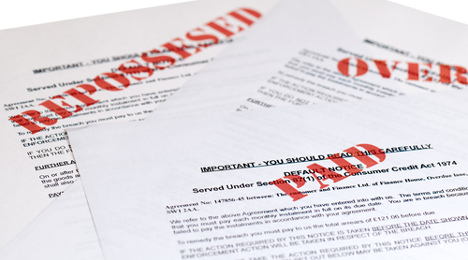FactorTrust recently released its enhanced Triggers solution, which provides tools to notify finance companies and other lenders of specific consumer behaviors on an ongoing basis and identifies the right-party contact information for collection and recovery efforts.
The company explained that Triggers are alerts for pre-specified consumer events or changes reflected on FactorTrust’s credit database that indicates a consumer is in the market for a certain product, is recently eligible for a product, or passed a certain risk threshold, prompting the lender to take action.
The next generation of Triggers enhances the lender’s ability to monitor consumer files and quickly respond with offers or actions to enable growth, reduce potential loss and streamline collections efforts. The new version’s enhanced features for account management and collections include:
—New customer file management functionality with an ability to download lists of all consumers being monitored
—Five new event triggers
—Additional output fields for payment type and frequency, and bank account numbers
—Weekly summary emails to customers
“Our experienced team of data and analytics experts are continuously increasing ease and usefulness of our products and offerings, with our customers in mind,” FactorTrust chief executive officer Greg Rable said in a news release.
“The upgraded features of Triggers enable lenders interested in monitoring customer accounts to not only help to reduce losses, but also grow their portfolios more efficiently.”
For more information on FactorTrust, visit www.FactorTrust.com or call (866) 910-8497.
Since retiring for the second time from Exeter Finance, Mark Floyd certainly doesn’t appear to be reducing his industry involvement much.
DIMONT, one of the largest providers of insurance claims adjusting and collateral loss mitigation services to the residential mortgage and auto lending industries, on Monday announced that Floyd has joined the firm as a board member, with a special focus on the automotive finance industry.
As many industry participants know, Floyd is a seasoned auto finance executive, with more than 30 years of experience in banking and subprime lending. Most recently, he served as vice chairman and chief executive officer of Exeter. He also held senior management positions at AmeriCredit Corp., including chief operations officer and president of dealer services, and executive vice president of strategic alliances.
Prior to AmeriCredit, he served as president of the National Asset Placement Corp. and excelled in various leadership positions at banking institutions throughout Dallas.
After departing Exeter last fall, Floyd also has been president of the National Automotive Finance Association and joined Intellaegis to become its board chairman.
In his role as a DIMONT board member, the company said Floyd will assemble and lead an advisory panel designed to provide guidance in client/services development within the automotive finance industry.
“Mark has a proven track record of successfully building and leading a growing business platform,” said Denis Brosnan, president and chief executive officer of DIMONT. “We look forward to utilizing his expertise to help grow DIMONT’s solutions for the auto finance industry.
“His outstanding reputation in the industry, coupled with his wealth of experience and relationships, will help strengthen our presence as a best-in-class insurance claims service provider to auto lenders,” Brosnan continued.
Reflecting on his latest industry endeavor, Floyd added, “I look forward to building upon DIMONT’s strong foundation in the residential mortgage industry and expanding their reach into the auto finance space. Lenders will benefit tremendously from DIMONT’s products, service and dedication to excellence.”
As analysts discussed how commercial banks are viewing auto financing, they also spotted the largest sequential drop in the auto segment of the S&P/Experian Consumer Credit Default Indices in five years.
S&P Dow Jones Indices and Experian released its latest default data on Tuesday and the information through April showed auto loan defaults decreased 10 basis points from the previous month to 0.90 percent.
The last time the default rate dropped by at least 10 basis points came in 2012, when the March reading came in at 1.11 percent after landing at 1.22 percent in February of that year.
The month-over-month drop also resulted in the auto default rate settling below 1 percent for the first time since last July, which was the last one in a four-month stretch a year ago when the level sat below that threshold.
Meanwhile, the April composite rate — a comprehensive measure of changes in consumer credit defaults — decreased 4 basis points from previous month to 0.90 percent.
The first mortgage default rate also made a move lower, dropping 6 basis points from March to 0.69 percent.
Conversely, the bank card default rate increased 4 basis points from March to 3.35 percent, extending a streak of six consecutive sequential rises to reach a 46-month high. This segment’s rate hasn’t been this high since May 2013, when bank card default stood at 3.63 percent.
When comparing the bank card default rate among the four census divisions, analysts found the default rate in the South is considerably higher than the other three census divisions. The East South Central Census Region — comprised of Kentucky, Tennessee, Alabama and Mississippi — has the highest bank card default rate.
As per Bureau of Labor Statistics, S&P and Experian added that these states have some of the lowest median household income.
Looking elsewhere, analysts found that four of the five major cities saw their default rates decrease in the month of April.
Chicago experienced the largest decrease, down 11 basis points from March to 0.94 percent.
Dallas and Miami each reported decreases of 10 basis points from the previous month to 0.69 percent and 1.30 percent, respectively.
Los Angeles was down 6 basis points from March to 0.69 percent.
At 1.10 percent, New York was the only city reporting a default rate increase of 1 basis point from previous month.
David Blitzer, managing director and chairman of the index committee at S&P Dow Jones Indices, offered his recap of the latest Federal Reserve survey that offered insight into how banks are approaching auto finance.
“Default rates on bank cards continue to creep higher while default rates on auto loans are little changed,” Blitzer said.
“The Federal Reserve's quarterly survey of senior bank loan officers revealed that a modest fraction of banks tightened standards on credit card loans and a similar portion of banks were tightening standards for auto loans,” he continued. “Banks also raised the spread over their cost of funds and increased the minimum credit scores required for auto loans. The same Fed survey showed weakening demand for auto loans.
“Separately, auto sales declined during the first quarter before seeing a slight rise in April. Demand for bank card loans was mixed according to the Fed survey,” Blitzer went on to say.
Blitzer also touched the mortgage portion of the Fed survey.
“Default rates on first mortgages are steady as home prices continue to rise in most parts of the country and sales of both new and existing homes increase,” he said. “The Fed survey reported little change in either demand for mortgage loans or mortgage lending standards.
“The level of outstanding mortgage debt bottomed in the second quarter of 2014 and has been increasing steadily since then,” Blitzer continued. “After almost three years, outstanding mortgage debt is 9 percent below the peak seen in the first quarter of 2008.
“Some analysts question if continuing increases in home prices presage a new housing bubble. Given conditions in the mortgage markets, this is not a current concern,” he added.
Jointly developed by S&P Indices and Experian, analysts noted the S&P/Experian Consumer Credit Default Indices are published monthly with the intent to accurately track the default experience of consumer balances in four key loan categories: auto, bankcard, first mortgage lien and second mortgage lien.
The indices are calculated based on data extracted from Experian’s consumer credit database. This database is populated with individual consumer loan and payment data submitted by lenders to Experian every month.
Experian’s base of data contributors includes leading banks and mortgage companies and covers approximately $11 trillion in outstanding loans sourced from 11,500 lenders.
So far this year, a wide array of investment analysts are asking finance companies that bring in any non-prime or subprime paper about their current risk appetite. Another occasion came when Santander Consumer USA hosted its quarterly conference call recently, in which the finance provider reported a total year-over-year origination volume drop of 21 percent in the first quarter.
While SCUSA originations came in at $5.4 billion, the company took action to compensate itself for risk since the average FICO score of the contract holder attached to the originated paper it retained ticked down to 593 from 601 a year earlier. As a result, SCUSA pushed the average APR on those contracts up to 17.0 percent, up from 15.3 percent.
President and chief executive officer Jason Kulas explained during his opening remarks that SCUSA Q1 originations with FICO scores below 640 in its core and Chrysler Capital channels decreased 16 percent and 33 percent, respectively, versus the prior-year quarter.
Part of what triggered concern from Wall Street was SCUSA’s nearly $26 million regulatory punishments involving the attorneys general in Massachusetts and Delaware. Kulas referenced the company’s presentation that mentioned more than 800 dealerships have been terminated for performance-related issues.
The company went on to say it “further enhanced dealer oversight to include qualitative metrics such as negative media, false documents and consumer complaints. If dealers breach any of the qualitative or quantitative metrics and performance does not improve, SC may terminate the dealership.”
Kulas added, “As the industry continues to focus on this area, we are committed to be leaders in dealer management, moving beyond the traditional methods of monitoring credit performance.”
Furthermore, Kulas was asked to explain if the paper SCUSA is now accepting — especially in the lower credit tiers — should perform better than what the company originated in 2015 within similar credit segments. Multiple conference call participants made the comparison, insinuating how that 2015 vintage isn’t performing up to expectations.
The company did acknowledge that its net charge-off and delinquency ratio for its retail installment contracts increased to 8.8 percent and 3.9 percent, respectively, for the first quarter of 2017 from 7.6 percent and 3.1 percent, respectively, a year earlier. SCUSA noted the increases in the net charge-off and delinquency ratios, and in troubled debt restructurings (TDR) balances, were driven by the aging of the more non-prime 2015 vintage and slower portfolio growth since the prior year first quarter.
“We always want to maximize our capture with all applications that we get. The issue we always have is that many times at different parts of the credit spectrum at different times what we think is the right pricing structure, the market may have a different view so we get less,” Kulas said when asked about those metrics during the call.
“Our cash rate to non-prime, even though they’re up sequentially, are still in the high single digits, which historically is the range we’ve been and that’s the range that has served us well through several cycles,” he continued. “So, for us, we track competitive factors, we track market share, we look at volume, but what we really want is the right risk adjusted return for every single asset we book, and that’s where we’re going to be focused; not on doing more or less of any certain part of the credit spectrum.”
Kulas then addressed the specificity of the newest vintage against what came into its portfolio so far this year.
“I will say, being specific about comparing 2015 to what we’ve originated so far in 2017, there are some very key differences,” Kulas said. “We feel like our — going back to the other comments about the trade-off in risk adjusted yield versus loss — we feel like there’s a much better trade-off in our early 2017 vintages on those two factors than what we had in 2015. There are certain pockets of what we originated in 2015 that we are no longer originating. So, just by definition in terms of our approach to the market, it’d be different.
“We saw that same thing, by the way, when we went through 2006 and 2007,” he continued. “When you go through those types of situations, you learn from them. You leverage your data, you make decisions based on what you’re seeing and some things you never do again and some things you just make sure you price for.
“For us, it’s a little bit of both. That’s what we’re doing,” Kulas went on to say. “We’re learning from what we see. We’re factoring it into the new originations and we would expect that, for example, if we were sitting here on our second quarter call talking about incremental growth in non-prime originations, that we would be getting more than paid for those originations and we’d feel very good about them, or we won’t do them.”
All of the Q1 activity left SCUSA with $143 million in net income, down from $208 million a year earlier.
“We believe there’s a direct connection between strong consumer practices, a culture of compliance and the creation of shareholder value,” Kulas said near the end of his opening remarks. “Simply stated, the companies that embrace and execute on these concepts will be more successful than those who do not.
“In 2017, SC will drive value through enhancing compliance controls and consumer practices, continued credit discipline, diverse and stable sources of liquidity, industry leading efficiency and technology, a focus on recognizing upside in Chrysler Capital through dealer VIP, floorplan and the Santander flow program, and finally, being simple, personal and fair with our customers, employees in all constituencies,” he went on to say.
Credit Acceptance Corp. appears well aware of the risk the finance company is taking as installment contract dollar amounts as well as terms keep growing.
But that risk is certainly paying off — literally — as the company’s first quarter consolidated net income jumped by nearly $20 million year-over-year.
Credit Acceptance reported that Q1 consolidated net income came in at $93.3 million, or $4.72 per diluted share, up from $74.4 million, or $3.63 per diluted share, in the year-ago quarter.
The company added that adjusted net income, a non-GAAP financial measure, for the three months that ended March 31 totaled $92.3 million, or $4.67 per diluted share, compared to $82.3 million, or $4.02 per diluted share, for the same period in 2016.
Credit Acceptance indicated its origination unit volume declined 6.6 percent as the finance company added 94,809 installment contracts. Driven by multiple factors, Credit Acceptance mentioned dollar volume associated with those originations grew 6.4 percent during the first quarter.
Management reported the number of active dealers in its network rose by 4.8 percent to 7,851, but the company acknowledged average volume per active dealer declined 11.0 percent.
“Dollar volume grew while unit volume declined during the first quarter of 2017 due to an increase in the average advance paid per unit,” Credit Acceptance said. “This increase was the result of an increase in the average size of the consumer loans assigned primarily due to an increase in the average initial loan term and an increase in purchased loans as a percentage of total unit volume, partially offset by a decrease in the average advance rate due to a decrease in the average initial forecast of the consumer loans assigned.
“Our progress in growing unit volumes has slowed considerably over the last five quarters,” the company continued. “For the most recent two quarters, unit volumes declined as compared to the same periods of the prior year. This trend reflects the difficulty of growing the number of active dealers fast enough to offset the impact of the competitive environment on attrition and per dealer volumes.
“In addition, in response to the decline in forecasted collection rates experienced in 2016, we adjusted our initial collection forecasts downward during 2016. While the adjustments have been modest, we believe these adjustments have had an adverse impact on unit volumes,” Credit Acceptance went on to say.
During the company’s conference call with investment analysts, Credit Acceptance chief executive officer Brett Roberts mentioned that the finance provider average term for contracts written in Q1 averaged 54 months. However, Roberts declined to give loan-to-value metrics when asked about the company’s risk appetite and mitigation.
“The loan term is disclosed. You can see we’ve got a little bit longer this quarter. We don’t disclose loan-to-value. But as we’ve talked about with the term, it’s a mix issue,” Roberts said.
“We write loans with terms of 24 months up to 72 months. For about 80 percent of the loans we write, we have a full amortization period behind us. We’ve got a full history on how those loans will perform,” he continued. “And for the 66-month and 72-month loans, we don’t have a full history. I think we’re about 75 percent of the way through the 66 months. So, we have 48 to 50 months of history there. And on the 72, we have about between 24 and 30 months of history on those. So, we feel like for most loans we write, we’ve got good data to back it up.
“For the 72-month loans, we have to do a little bit of estimation, so there’s a little bit more risk there,” Roberts added. “But because we’ve got a lot of 60s and lot of 66-month loans on which to base it, we don’t think it’s a stretch to be able to forecast those with a high degree of accuracy.”
Securitization update
The last securitzation Credit Acceptance finalized came back on Feb. 23 when the company announced the completion of a $350.0 million asset-backed non-recourse secured financing. Pursuant to that transaction, Credit Acceptance contributed contracts having a net book value of approximately $437.8 million to a wholly-owned special purpose entity that issued three classes of notes.
Wall Street observers asked the company for its current impression of the auto ABS market.
“Well, speaking relative to conditions in the capital markets, certainly nothing that we’re seeing at this point that would indicate that the ABS market is less available to the industry than it has been,” Credit Acceptance senior vice president and treasurer Doug Busk said.
“Spreads were very attractive in Q1. They have widened a bit since then, but are still at relatively attractive levels. So, certainly, nothing on the funding side,” Busk continued.
When Busk mentioned spreads, it triggered more inquires during the call as one investment analyst wondered about another finance company posting a “pretty widening spread in the bottom tranches” of its offering.
The call participant asked, “Do you think that’s a one-off situation with the placement of that deal or do you think that’s a trend that we might actually see investors place lower demand on bottom tranches of ABS deals?”
Busk replied, “It’s a good question, and it’s a little bit tough to say because there hasn’t been a lot of subprime auto issuance real deep in the capital stack over the last few weeks. Certainly, spreads have widened out in general a little bit, but the widening has been much more extreme on the BB and BBB tranches than it has on the higher-rated tranches.
“So I think at this point it’s a little bit premature to conclude on that point. We’ll just have to watch subsequent issuances and see what happens,” he added.
Rising cost of doing business
Elsewhere in Credit Acceptance’s Q1 financial report, the company mentioned an increase in salaries and wages expense of $4.2 million, or 13.4 percent. Credit Acceptance also had an increase in sales and marketing expense of $3.5 million, or 30.2 percent, primarily as a result of “an increase in sales commissions driven by higher consumer loan assignment unit volume related to seasonality and an increase in the size of our sales force.”
The company said it also had an increase in general and administrative expense of $1.4 million, or 11.2 percent, stemming mostly from of an increase in “legal fees.”
“We’re in the process of expanding the numbers of salespeople that we have,” Roberts said. “The number at the end of Q1 was higher than the start of Q1 but a lot of those salespeople are new so we haven’t seen much of an impact yet in terms of the unit volume numbers.
“But hopefully as they become more seasoned, we’ll see a positive impact from that,” he added.
S&P Global Ratings recently considered what two specific areas contain the most risk since loosening underwriting resulted in U.S. auto loans and leases rising steadily over the past several years to reach all-time highs in 2016.
With more than $1 trillion in outstanding balances, S&P Global Ratings acknowledged the figure has raised questions about whether the growth will ultimately lead to significant asset quality deterioration and increased depreciation on leases, as well as which finance companies will bear the impact. The firm considered those questions and more in recent article titled, “How Worsening Auto Finance Conditions Could Affect Banks, Nonbank Finance Companies, and Captive Finance Companies.”
Adding to analysts’ concerns are subprime auto delinquencies climbing recently while used-vehicle prices have somewhat declined.
“We believe the greatest areas of market and credit risks are leasing and nonprime —including subprime —lending, respectively, and the financial institutions with significant concentrations in those areas, or in auto finance in general, are at risk of declining earnings or even bottom-line losses,” said S&P Global Ratings credit analyst Brendan Browne.
S&P Global Ratings reminded the industry that the financial institutions the firm rates includes captive auto finance companies owned by manufacturers given that they hold the lion's share of leases. Because of their contract exposure, the firm also mentioned that its recent analysis includes two nonbank auto finance companies — DriveTime Automotive Group and Credit Acceptance — as well as a handful of banks, most notably Santander Holdings USA and Ally Financial.
"If used-car prices continue to fall, the captives likely will have to report higher depreciation expenses on their leases, and non-prime lenders will have lower recoveries on defaulted loans,” Browne said. “A further increase in delinquencies and losses on loans would affect lenders. We could lower our ratings on companies in auto finance if these trends were severe enough.”
With regard to the used-vehicle prices, the Manheim Used Vehicle Value Index came in at 124.7 in April, which was up 1.6 percent year-over-year. According to a report accompanying the index, wholesale prices climbed 0.5 percent from March on a mix-, mileage- and seasonally adjusted basis.
In an analysis accompanying the index, Cox Automotive chief economist Tom Webb downplayed the concern many analysts have expressed about used-car price declines.
“Although the Manheim Used Vehicle Value Index increased for the first time this year on a month-over-month basis, used-vehicle values have not collapsed the way many analysts have warned of for more than a year due to expected increases in wholesale supplies,” Webb said. “And in fact, what weakness we have seen is probably more a result of excessive new-vehicle inventory, not used.”
Meanwhile, TransUnion reported the auto finance delinquency rate increased from 1.16 percent in Q1 2016 to 1.30 percent in Q1 2017, driven by poorer payment performance in the subprime and near prime segments.
“Serious auto loan delinquency rates are approaching levels not seen since the recession, but it’s important to understand that delinquencies in the auto market never elevated to levels observed for other key credit products such as credit cards and mortgages,” said Brian Landau, senior vice president for financial services and automotive business leader for TransUnion.
“Regardless, with flatter sales volumes and higher delinquencies, we anticipate lenders will evaluate their credit policies for subprime and near prime borrowers to calibrate for the uptick in delinquencies,” Landau continued.
S&P Global Ratings indicated a few factors that provide some protection against ratings downgrades include support from parents (as in the case of the captives and Santander), diversification outside of auto (for most banks), and ratings that already factor in an expectation of high losses on auto loans (as in the case of the nonbank finance companies).
“Still, we view worsening conditions in auto finance as a negative rating factor for all of these companies,” S&P Global Ratings said.
The S&P Global Ratings report is available to subscribers of RatingsDirect at www.globalcreditportal.com and at www.spcapitaliq.com.
Staff writer Joe Overby contributed to this report.
TransUnion’s Industry Insights Report offered clear evidence that auto finance originations are slowing, especially in the subprime space.
The credit bureau’s report, powered by Prama analytics and released on Tuesday, indicated that auto finance originations, viewed one quarter in arrears, declined to 6.66 million to end 2016, down 0.2 percent relative to fourth quarter of 2015. This movement marks the second consecutive quarter in which total originations were down year-over-year.
Analysts found that subprime originations posted the steepest decline in originations, dropping by 5 percent.
The latest Industry Insights Report also highlighted that outstanding auto finance balances continued to grow at a more moderate pace in the first quarter of 2017. Total auto finance balances reached $1.12 trillion, up from $1.05 trillion in Q1 2016.
The year-over-year growth rate in Q1 2017 was 7.3 percent, the lowest level TransUnion has observed since Q2 2012.
Analysts determined the average auto finance balance per consumer rose to $18,386, up 1.8 percent from $18,065.
TransUnion reported the auto finance delinquency rate increased from 1.16 percent in Q1 2016 to 1.30 percent in Q1 2017, driven by poorer payment performance in the subprime and near prime segments.
“Serious auto loan delinquency rates are approaching levels not seen since the recession, but it’s important to understand that delinquencies in the auto market never elevated to levels observed for other key credit products such as credit cards and mortgages,” said Brian Landau, senior vice president for financial services and automotive business leader for TransUnion.
“Regardless, with flatter sales volumes and higher delinquencies, we anticipate lenders will evaluate their credit policies for subprime and near prime borrowers to calibrate for the uptick in delinquencies,” Landau continued.
As Landau referenced, similar trends are appearing in other credit segments that TransUnion watches as analysts mentioned personal loan balances grew while subprime originations slowed.
TransUnion said the total balance for unsecured personal loans grew 9.7 percent to $102 billion in Q1 2017. One year prior, personal loan balances were $93 million. The year-over-year growth rate slowed compared to prior first quarters, when the yearly growth rate averaged 19.9 percent between 2013 and 2016.
Analysts calculated the average personal loan balance was $7,603 in the first quarter, a slight increase from $7,544 in Q1 2016. In the last five years, personal loan balances have grown by $1,709 from $5,893 in Q1 2012.
“Personal loan balances have increased rapidly in the last five years, but we observed a slowdown in the growth of both total balances and average balances in the first quarter,” said Jason Laky, senior vice president and consumer lending business leader at TransUnion.
“While the first quarter is usually lighter volume for personal loans, as consumers use tax returns or bonuses for purchases and to pay down debts, the beginning of 2017 experienced a larger than normal decline,” Laky added.
At the end of 2016, personal loan originations, viewed one quarter in arrears, declined 10.8 percent from 4.10 million in Q1 2016 to 3.66 million in Q1 2017. Subprime (down 12.6 percent) and near-prime (down 13.5 percent) originations experienced the sharpest year-over-year drops in originations.
TransUnion went on to note the personal loan delinquency rate also ticked up slightly to open 2017. The delinquency rate was 3.72 percent, a 3.6-percent increase from the year-ago reading of 3.59 percent.
With delinquencies an ongoing concern, FICO said it has crafted a way to prioritize the account holders with the highest likelihood of paying.
FICO discussed the process in its latest white paper, delving into the topic by discussing five questions managers often consider, such as:
• What do analytics tell you about your delinquent accountholders?
• What are collection scores, and how do they enable you to prioritize delinquent accounts for follow-up?
• How does combining different collection scores provide additional strategic insights?
• How do analytics enable you to reallocate resources to improve results?
• How did one organization use analytics to boost collected amount by 50 percent?
“Many collections and recovery organizations track performance using only numerical values such as average collections balance and total collected amount,” FICO said in the white paper titled, “0 to 60 – Accelerate Gains with C&R Analytics.”
Authors continued with, “Such measures tell you about the results you produced, but not much about why. And when period-over-period results shift up or down, they don’t help diagnose the causes of change.
“A more revealing way to look at your delinquent populations and results is with metrics based on account behavioral outcomes, such as payment rates, payment size and amount collected per account. Viewing populations according to such measures, you gain insights into why you’re achieving certain results,” they went on to say.
To download the FICO Insights white paper, go to this website.
The auto finance component of the S&P/Experian Consumer Credit Default Indices showed contract defaults improved in March both on a year-over-year and sequential basis.
According to data released by S&P Dow Jones Indices and Experian, auto loan defaults came in at 1.00 percent, down 5 basis points from the previous month. In March of last year, the rate stood at 1.02 percent.
Analysts indicated the March composite rate — a comprehensive measure of changes in consumer credit defaults — remained unchanged from the previous month, holding at 0.94 percent in March.
The bank card default rate registered at 3.31 percent, up 9 basis points from February.
The first mortgage default rate came in at 0.75 percent, up 1 basis point from February and reaching a one-year high.
The five major cities S&P and Experian track for this report showed mixed results in March with two higher and three lower default rates.
New York had the largest increase, reporting in at 1.09 percent, up 15 basis points from February.
Chicago posted at 1.05 percent for March, rising 6 basis points from the previous month.
Miami came in at 1.40 percent, down 2 basis points from February.
Dallas reported a decrease of 4 basis points at 0.79 percent.
Los Angeles saw its first default rate decrease since September of last year, down 5 basis points to settle at 0.75 percent.
Where analysts raised concerns stemmed from the national bank card default rate, which came in at 3.31 percent in March. That reading sets a 45-month high.
When comparing the bank card default rate among the four census divisions, S&P and Experian determined the bank card default rate in the South is considerably higher than the other three census divisions.
Upon further analysis to the South’s three census regions, East South Central — comprised of Kentucky, Tennessee, Alabama, and Mississippi — has the highest bank card default rate.
Despite the bank card default metrics, David Blitzer, managing director and chairman of the index committee at S&P Dow Jones Indices, was mostly upbeat about the March data.
“The continuing low consumer credit default rate reflects recent strong job growth and a favorable economy,” Blitzer said. “The economy is also supporting consumers’ positive outlook and strong sentiment about the economy and their financial condition.
“Data from the Federal Reserve shows that consumer credit continues to expand at more than 6 percent per year, the highest pace since 2007-2008,” he continued. “Other Federal Reserve data indicate that household net worth in 2015 and 2016 rose 2.3 percent each year.
“Currently the debt service ratio for consumer credit — the percentage of disposable income required to service consumer credit debt — is 5.58 percent, up from its recent low of 4.92 percent in 2012 but lower than the 6.01 percent peak seen shortly before the financial crisis,” Blitzer went on to say.
“The higher interest rates that most analysts expect over 2017-2018 are likely to combine with continued growth in consumer credit to push the debt service ratio back towards the 6 percent level,” he added.
Jointly developed by S&P Indices and Experian, analysts noted the S&P/Experian Consumer Credit Default Indices are published monthly with the intent to accurately track the default experience of consumer balances in four key loan categories: auto, bankcard, first mortgage lien and second mortgage lien.
The indices are calculated based on data extracted from Experian’s consumer credit database. This database is populated with individual consumer loan and payment data submitted by lenders to Experian every month.
Experian’s base of data contributors includes leading banks and mortgage companies and covers approximately $11 trillion in outstanding loans sourced from 11,500 lenders.
Hudson Cook associate Anastasia Caton observed last week’s oral arguments during a crucial debt collection case in front of the Supreme Court that might make third-party efforts within auto finance significantly more difficult depending which way the nine justices rule.
To recap, the nation’s highest court will decide whether a company that regularly attempts to collect debts it purchased after the debts had fallen into default is a “debt collector” subject to the Fair Debt Collection Practices Act (FDCPA).
The matter involves the Supreme Court opting to hear the appeal of a debtor from a decision by the U.S. Court of Appeals for the Fourth Circuit. Caton previously explained that the case began when consumer Ricky Henson defaulted on a retail installment sale contract secured by a vehicle. After the original creditor repossessed and sold Henson's vehicle and applied the net proceeds to the balance, Caton noted a deficiency remained.
Eventually, the creditor sold Henson’s outstanding deficiency to Santander Consumer USA and Santander began collecting Henson’s deficiency
With that situation as the foundation for oral arguments, Caton described her overall assessment of how the proceedings unfolded in a message to SubPrime Auto Finance News.
“The proceeding seemed to focus heavily on the textual arguments — likely because counsel for the consumers used a creative argument for interpreting the FDCPA to apply to debt buyers,” Caton said.
“Counsel for the consumers argued that the definition of ‘debt collector’ — essentially, any person who regularly collects debts owed or due another — means that a company is a debt collector if it collects debts that were at one time owed to another person, or that are currently due to the company,” she continued.
“Several of the justices, including both (Samuel) Alito and (Elena) Kagan, seemed to agree that this interpretation of the definition of ‘debt collector’ involved an exercise in mental gymnastics,” Caton went on to say.
Caton asserted the textual arguments tend to support Santander’s claim that an entity that collects debt that it owns is not a “debt collector.”
She then added, “But, Justice (John) Roberts readily acknowledged that at the time the FDCPA was enacted, the debt buying industry as we know it did not exist.”
SubPrime Auto Finance News asked Caton if she could pinpoint what justice’s questions gave the most insight into how the high court is approaching this matter and how it might eventually rule. She circled back to the actions by Kagan and Alito, surmising that these two high court members seemed to agree that the consumers’ textual argument is weak.
“But no one mentioned that if there is a hole in the plain language of the statute as a result of changes in the industry, then Congress should amend the statute,” Caton said.
Caton also mentioned the focus both Kagan and Ruth Bader Ginsburg took regarding the consumers’ policy argument. Caton explained that under Santander’s interpretation of the FDCPA, a debt collector servicing accounts on behalf of a third party could simply buy those accounts to evade application of the FDCPA.
“(The justices) seemed to acknowledge that this is a problem that Congress could not have foreseen or intended at the time it drafted the FDCPA,” Caton said.
Caton added one more point regarding how the justices’ behavior might give an indication of how the Supreme Court might rule before its current term culminates this summer.
“The one thing that was absolutely clear from oral argument is that it will be a high hurdle for the court to overcome the plain language of the statute — notwithstanding that the majority of circuit courts to review this issue have found that debt buyers are ‘debt collectors’ subject to the FDCPA,” she said.
Depending on the result, SubPrime Auto Finance News asked Caton to project what might the ramifications be on the auto finance industry as well as the debt collection space.
Caton began by noting many of the largest debt buyers, relying on the majority of circuit courts, which have held that the FDCPA applies to debt buyers, already comply with the FDCPA.
Further, she added the Consumer Financial Protection Bureau has indicated in preliminary rulemaking materials promulgated under the FDCPA that it believes that debt buyers are subject to the FDCPA.
“So, if the court does rule in favor of the consumers, we likely will not see a huge impact on the debt buying or third party collection industries,” she said.
If the court decides that the statute does not apply to debt buyers, Caton predicted shifts in the third-party collection market and the debt buying/selling market.
“Many third party collectors will probably move to purchasing accounts outright,” she said. “More debt buyers will enter the market in the absence of the high compliance burden hurdles posed by the FDCPA.
“As a result, the debt sales market will likely become more competitive for auto finance companies trying to sell off old deficiency balances, but creditors might also have a harder time finding third parties to service delinquent accounts,” Caton continued.
Caton touched on another potential ramification if a decision goes in Santander’s favor. She sees an impact on state collection agency and debt collection laws that have adopted the FDCPA’s definitions, and, in the absence of definitive state regulator or case law guidance, rely on FDCPA jurisprudence.
In fact, Caton pointed out attorneys general from 28 states and the District of Columbia joined in an amicus brief supporting the consumers’ argument that debt buyers are debt collectors.
“Perhaps the most significant impact of a decision in Santander’s favor would be Congress revising the FDCPA to remove any doubt that it clearly applies to debt buyers. The court very well could signal to Congress in its opinion that it should do just that,” Caton said.












